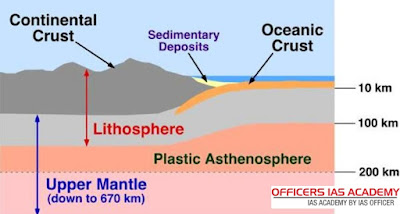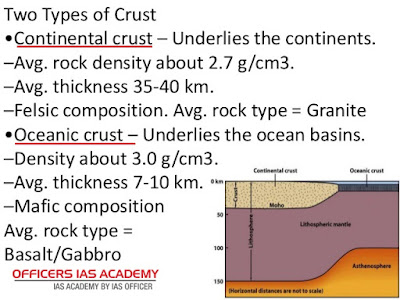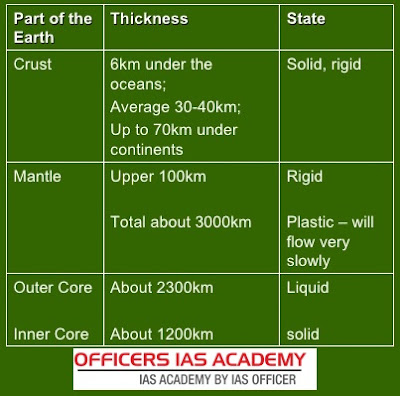Internal structure of earth :
The earth is made up of several
concentric layers. Concentric means having a common centre. The earth has one
layer inside another.
Broadly, there are three
layers of the earth:
a. Crust
b. Mantle
c. Core
a. Crust
b. Mantle
c. Core
The Crust:
·
It is the outermost layer over the earth’s surface.
·
It is the thinnest of all the layers.
·
About 35 km on the continental masses and only 5 km on the ocean
floors.
·
The main minerals constituting the continental mass are:
• Silica
• Alumina
• Silica
• Alumina
·
The continental mass is also called ‘sial’.
·
The name sial is derived from letters ‘si’ of silicon and ‘al’
of alumina.
·
The main mineral constituents of the oceanic crust are:
• Silicon
• Magnesium
• Silicon
• Magnesium
·
The oceanic crust is called ‘sima’.
·
The root of the word sima
is ‘si’ from silica and ‘ma’ from magnesium.
Mantle :
·
It is the layer just beneath the crust and extends up to a depth
of 2900 km below the crust.
·
As Earth began to take shape about 4.5 billion years ago, iron
and nickel quickly separated from other rocks and minerals to form the core of
the new planet.
·
The molten material that surrounded the core
was the early mantle.
·
Over millions of years, the mantle cooled.
Water trapped inside minerals erupted with lava, a process called “outgassing.”
·
As more water was outgassed, the mantle solidified.
·
The transfer of heat and material in the mantle helps determine
the landscape of Earth.
·
Activity in the mantle
drives plate tectonics, contributing to volcanoes, seafloor spreading,
earthquakes, and orogeny (mountain-building).
Asthenosphere :
·
The asthenosphere is the denser, weaker layer beneath
the lithospheric mantle.
Core :
·
It is the innermost layer .
·
The core consists of
outer core and inner core.
·
It is mainly made up of:
• Nickel
• Iron
• Nickel
• Iron
·
The innermost layer is also called ‘nife’.
·
The name nife is derived from the word ‘ni’ from nickel and ‘fe’
from ferrous meaning iron.
·
The temperature and
pressure of the central core is very high.
Outer Core :
·
mostly composed of liquid iron and nickel.
Inner Core :
·
The temperature of the inner core is far above the melting point
of iron.
·
However, unlike the outer core, the inner core is not liquid or
even molten.
·
The inner core’s intense pressure—the entire rest of the planet
and its atmosphere—prevents the iron from melting




















in a very lucid manner broken down the topic...nice work
ReplyDelete